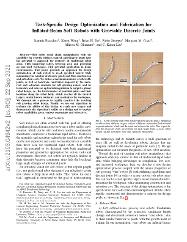| dc.contributor.author | Exarchos, I. | |
| dc.contributor.author | Wang, K. | |
| dc.contributor.author | Do, B.H. | |
| dc.contributor.author | Stroppa, F. | |
| dc.contributor.author | Coad, M.M. | |
| dc.contributor.author | Okamura, A.M. | |
| dc.contributor.author | Liu, C.K. | |
| dc.date.accessioned | 2023-10-19T15:05:15Z | |
| dc.date.available | 2023-10-19T15:05:15Z | |
| dc.date.issued | 2022 | |
| dc.identifier.isbn | 9781728196817 | |
| dc.identifier.issn | 1050-4729 | |
| dc.identifier.uri | https://doi.org/10.1109/ICRA46639.2022.9811611 | |
| dc.identifier.uri | https://hdl.handle.net/20.500.12469/4775 | |
| dc.description | IEEE;IEEE Robotics and Automation Society (RA) | en_US |
| dc.description | 39th IEEE International Conference on Robotics and Automation, ICRA 2022 --23 May 2022 through 27 May 2022 -- --180851 | en_US |
| dc.description.abstract | Soft robot serial chain manipulators with the capability for growth, stiffness control, and discrete joints have the potential to approach the dexterity of traditional robot arms, while improving safety, lowering cost, and providing an increased workspace, with potential application in home environments. This paper presents an approach for design optimization of such robots to reach specified targets while minimizing the number of discrete joints and thus construction and actuation costs. We define a maximum number of allowable joints, as well as hardware constraints imposed by the materials and actuation available for soft growing robots, and we formulate and solve an optimization problem to output a planar robot design, i.e., the total number of potential joints and their locations along the robot body, which reaches all the desired targets, avoids known obstacles, and maximizes the workspace. We demonstrate a process to rapidly construct the resulting soft growing robot design. Finally, we use our algorithm to evaluate the ability of this design to reach new targets and demonstrate the algorithm's utility as a design tool to explore robot capabilities given various constraints and objectives. © 2022 IEEE. | en_US |
| dc.description.sponsorship | National Science Foundation, NSF: 1953008, 2024247; Achievement Rewards for College Scientists Foundation, ARCS | en_US |
| dc.description.sponsorship | This work was supported in part by National Science Foundation grants 1953008 and 2024247, a National Science Foundation Graduate Research Fellowship, and an ARCS Foundation Fellowship. | en_US |
| dc.language.iso | eng | en_US |
| dc.publisher | Institute of Electrical and Electronics Engineers Inc. | en_US |
| dc.relation.ispartof | Proceedings - IEEE International Conference on Robotics and Automation | en_US |
| dc.rights | info:eu-repo/semantics/openAccess | en_US |
| dc.subject | Machine design | en_US |
| dc.subject | Design optimization | en_US |
| dc.subject | Home environment | en_US |
| dc.subject | Inflated beams | en_US |
| dc.subject | Joint constraint | en_US |
| dc.subject | Minimizing the number of | en_US |
| dc.subject | Robot arms | en_US |
| dc.subject | Robot designs | en_US |
| dc.subject | Serial chains | en_US |
| dc.subject | Soft robot | en_US |
| dc.subject | Stiffness control | en_US |
| dc.subject | Manipulators | en_US |
| dc.title | Task-Specific Design Optimization and Fabrication for Inflated-Beam Soft Robots with Growable Discrete Joints | en_US |
| dc.type | conferenceObject | en_US |
| dc.identifier.startpage | 7145 | en_US |
| dc.identifier.endpage | 7151 | en_US |
| dc.department | N/A | en_US |
| dc.identifier.doi | 10.1109/ICRA46639.2022.9811611 | en_US |
| dc.identifier.scopus | 2-s2.0-85136336896 | en_US |
| dc.institutionauthor | N/A | |
| dc.relation.publicationcategory | Konferans Öğesi - Uluslararası - Kurum Öğretim Elemanı | en_US |
| dc.authorscopusid | 56692824600 | |
| dc.authorscopusid | 57295990500 | |
| dc.authorscopusid | 57220397579 | |
| dc.authorscopusid | 54891556200 | |
| dc.authorscopusid | 57197734607 | |
| dc.authorscopusid | 7103344370 | |
| dc.authorscopusid | 10140418300 | |
| dc.khas | 20231019-Scopus | en_US |
















